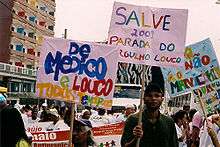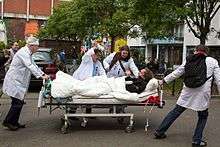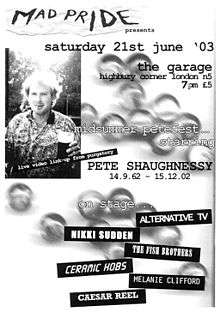Mad Pride
Mad Pride is a mass movement of the users of mental health services, former users, and the aligned, and that individuals with mental illness should be proud of their 'mad' identity.[1] It was formed in 1993 in response to local community prejudices towards people with a psychiatric history living in boarding homes in the Parkdale area of Toronto, Ontario, Canada, and an event has been held every year since then in the city except for 1996.[2] A similar movement began around the same time in the United Kingdom. By the late 1990s similar events were being organized under the Mad Pride name around the globe, including Australia, Ireland, Portugal, Brazil, Madagascar, South Africa and the United States. Events draw thousands of participants, according to MindFreedom International, a United States mental health advocacy organization that promotes and tracks events spawned by the movement.[3]

Mad Pride activists seek to reclaim terms such as "mad", "nutter", and "psycho" from misuse, such as in tabloid newspapers and in order to switch it from a negative view into a positive view.[4] Through a series of mass media campaigns, Mad Pride activists seek to re-educate the general public on such subjects as the causes of mental disabilities, the experiences of those using the mental health system, and the global suicide pandemic. One of Mad Pride's founding activists in the UK was Pete Shaughnessy, who later died by suicide.[5] Mark Roberts, Robert Dellar (who died in 2016[6]) and Simon Barnet were among the other founders of the movement.[7] Mad Pride: A celebration of mad culture records the early Mad Pride movement.[8] On Our Own: Patient-Controlled Alternatives to the Mental Health System, published in 1978 by Judi Chamberlin, is a foundational text in the Mad Pride movement, although it was published before the movement was launched.[9]
The first known event, specifically organized as a Pride event by people who identified as survivors, consumers or ex-patients of psychiatric practices, was held on 18 September 1993, when it was called "Psychiatric Survivor Pride Day".
Mad Studies
Mad Studies grew out of Mad Pride and survivor thinking, and focuses on developing scholarly thinking around "mental health" by academics who self-identify as mad. As noted in Mad matters: a critical reader in Canadian mad studies (LeFrançois, Menzies and Reaume, 2013),[10] "Mad Studies can be defined in general terms as a project of inquiry, knowledge production, and political action devoted to the critique and transcendence of psy-centred ways of thinking, behaving, relating, and being".[10]:13 As a book, "'Mad Matters' offers a critical discussion of mental health and madness in ways that demonstrate the struggles, oppression, resistance, agency and perspectives of Mad people to challenge dominant understandings of ‘mental illness’".[11]:3 "Mad Studies is a growing, evolving, multi-voiced and interdisciplinary field of activism, theory, praxis and scholarship."[11]:1
History
Mad Pride was launched alongside a book of the same name, Mad Pride: A celebration of mad culture, published in 2000.[8] On May 11, 2008, Gabrielle Glaser documented Mad Pride in The New York Times.[12] Glaser stated, "Just as gay-rights activists reclaimed the word queer as a badge of honor rather than a slur, these advocates proudly call themselves mad; they say their conditions do not preclude them from productive lives."
Early origins
Elizabeth Packard (1816-1897) was deemed insane by her husband as she did not agree with his conservative political views. In Illinois at the time, involuntary admission to an asylum did not require a public hearing so long as it was a husband admitting his wife.[10] Due to this, Packard was institutionalized though she saw herself to be sane. In Packard’s lifetime to be labeled as ‘mad’ was a form of social disapproval. However, she felt solidarity among Mad people due to her experience in the institution. Though she did not personally identify as Mad and had to identify as ‘sane’ in order to be an activist, it is here that we see early forms of organizing from ex-patients.[10]
Mad culture and events

The Mad Pride movement has spawned recurring cultural events in Toronto, London, Dublin and other cities around the world. These events often include music, poetry readings, film screenings, and street theatre, such as "bed push" protests, which aim to raise awareness about the poor levels of choice of treatments and the widespread use of force in psychiatric hospitals.[13] Past events have included British journalist Jonathan Freedland,[14] and popular novelist Clare Allan.[15] Mad Pride cultural events take a variety of forms, such as the South London collective Creative Routes, the Chipmunka Publishing enterprise, and the many works of Dolly Sen.[16]
Bed push

A Bed Push is a method of activism employed by multiple mental health agencies and advocates as a method of raising awareness about psychiatric care. Activists wheel a gurney through public spaces to provoke discussion about mental health care. Mind Freedom has a recipe for a successful Bed Push on their website, urging participants to remain peaceful but also be seen by blowing horns, slightly disrupting traffic and playing music.[17] Often patients in psychiatric care feel silenced and powerless, showing resilience in the face of that and securing visibility is a method of regaining dignity.[18]
Mad Pride Week in Toronto is proclaimed as such by the city itself.[19] The festivities surrounding this week are highlighted by the Mad Pride Bed Push, typically on the 14th of July. The event takes place Toronto’s Queen Street West “to raise public awareness about the use of force and lack of choice for people ensnared in the Ontario mental health system” [20] This week is officially run by Toronto Mad Pride which partners a number of mental health agencies in the city. In recent years, some advocates have pushed for Parkdale, Toronto to be renamed MAD! Village, to reclaim pride in its surrounding communities' long history of struggle with mental health and addictions. [19]
A series of bed push events take place around London each year.
Psychiatric Patient Built Wall Tours
The Psychiatric Patient Built Wall Tours take place in Toronto, ON at the CAMH facility on Queen St West. The tours show the patient built walls from the 19th century that are located at present day CAMH. The purpose of the tours is to give a history on the lives of the patients who built the walls, and bring attention to the harsh realities of psychiatry.
Geoffrey Reaume and Heinz Klein first came up with the idea of walking tours as part of a Mad Pride event in 2000. The first wall tour occurred on what is now known as Mad Pride Day, on July 14, 2000, with an attendance of about fifty people. Reaume solely leads the tours, and they have grown from annual events for Mad Pride, to occurring several times throughout the year in all non-winter months.[21]
See also
- Anti-psychiatry
- Clifford Whittingham Beers
- Disability rights movement
- Elizabeth Packard
- Icarus Project
- Involuntary commitment
- Judi Chamberlin
- Kate Millett
- Leonard Roy Frank
- Linda Andre
- List of psychiatric consumer/survivor/ex-patient related topics
- Lyn Duff
- Mentalism (discrimination)
- National Empowerment Center
- Neurodiversity
- Psychiatric survivors movement
- Ted Chabasinski
- World Network of Users and Survivors of Psychiatry
References
- Cohen, Oryx (9 March 2017). "The Power of 'Healing Voices'". The Mighty. Retrieved 12 September 2018.
- Reaume, Geoffrey (July 14, 2008). "A History of Psychiatric Survivor Pride Day during the 1990s". The Consumer/Survivor Information Resource Centre Bulletin, No. 374.
- Glaser, Gabrielle (11 May 2008). "'Mad Pride' Fights a Stigma". Retrieved 16 April 2019 – via NYTimes.com.
- Glaser, Gabriell (11 May 2008). "Mad Pride' Fights a Stigma". New York Times. Retrieved 19 September 2018.
- "Account Suspended". www.mentalmagazine.co.uk. Retrieved 16 April 2019.
- "Activists mourn Robert Dellar, co-founder of Mad Pride and a 'tenacious force for good'". Disability News Service. 2016-12-22. Retrieved 2017-03-27.
- Abraham, Amelia (18 November 2016). "Remembering Mad Pride, The Movement That Celebrated Mental Illness". Retrieved 16 April 2019.
- Theodore R Curtis (1996). Mad Pride. Hackney, London: Spare Change Books. ISBN 0-95257-445-4.
- Lawrence, J.M. (20 January 2010). "Judi Chamberlin, writings took on mental health care". The Boston Globe. Retrieved 4 March 2011.
- Brenda LeFrançois, Robert Menzies and Geoffrey Reaume, editors (2013) Mad matters: a critical reader in Canadian mad studies, Toronto, Canadian Scholars’ Press Inc. ISBN 978-1-55130-534-9
- Mark Anthony Castrodale (2014) "Mad matters: a critical reader in Canadian mad studies", Scandinavian Journal of Disability Research, doi:10.1080/15017419.2014.895415
- Gabrielle Glaser (May 11, 2008). "'Mad Pride' Fights a Stigma". The New York Times. The New York Times Company. Retrieved May 11, 2008.
- "HugeDomains.com - BedPush.com is for sale (Bed Push)". www.hugedomains.com. Retrieved 16 April 2019.
- Brand, Jo (2007-05-08). "Glad to be 'mad'?". The Guardian. Archived from the original on November 4, 2007.
- Allan, Clare (2006-11-27). "Misplaced pride". Guardian Unlimited. Archived from the original on January 9, 2008.
- Dolly Sen (October 2002) World Is Full of Laughter: 1 Million People Commit Suicide Every Year, Chipmunka Publishing ISBN 978-0-95422-181-2
- "Bed Push Tips — MFIPortal". 19 January 2008. Retrieved 16 April 2019.
- "MindFreedom Journal — MFIPortal". 16 April 2008. Retrieved 16 April 2019.
- "MAD! Pride Breaks the Stigma of Mental Illness". www.blogto.com. Retrieved 16 April 2019.
- Brenda LeFrançois, Robert Menzies and Geoffrey Reaume, editors (2013) Mad matters: a critical reader in Canadian mad studies, Toronto, Canadian Scholars’ Press Inc. ISBN 978-1-55130-534-9
- "Psychiatric Patient Built Wall Tours at the Centre for Addiction and Mental Health (CAMH), Toronto, 2000 – 2010". ActiveHistory.ca. 2011-04-19. Retrieved 2017-03-13.
External links
| Wikimedia Commons has media related to Mad Pride. |
| Wikiquote has quotations related to: Mad Pride |